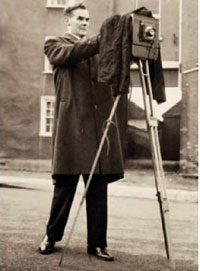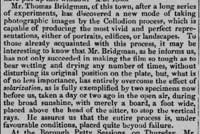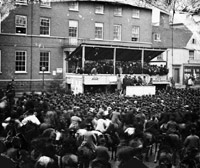 |
 |

|
Introduction
Once photography had passed its early invention stages, it settled down to the production of pictures using various sizes of glass plates, upon which a light sensitive solution was applied. The resulting image was known as a "negative" because it appeared darkest where the recorded light was greatest. The positive image appeared by exposing light through the negative on to a fresh light sensitive medium, usually based upon paper, although it could also be another glass plate.
Two main types of glass plate negatives exist: the collodion wet plate invented by Frederick Scoff Archer, in use from the 1850s, and the silver gelatin dry plate created by Dr. Richard L. Maddox, in use from the 1870s.
|
 |
The Collodion Wet Plate Process The collodion wet plate was invented by Frederick Scoff Archer, and was in use from the 1850s. The wet plates had to be hand coated by photographers just before use and then exposed while still wet. Collodion, a flammable liquid, was spread on a glass support, or plate, then placed into a bath of silver nitrate which turned the collodion into a photosensitive silver iodide. This process, including exposure and processing, had to happen immediately before the plate dried, which was about a five minute "window".
For the outdoor photographer such as William Spanton, he had to make use of a Wet-plate Dark Tent which could be home made or bought ready made from about 1860 by firms like Ernest Edwards, Patrick Meagher or Messrs Rouch. Such a tent had to include a sink or water bath, a silver nitrate bath, and facilities to fill and empty these. As far as is known, nothing further came of his photographic ideas, and he died in 1859. Bridgman seems to have been an enthusiastic inventor, as in 1852 and 1855 he patented a cornscreen together with Robert Boby which became a commercial success for Robert Boby Engineering. The Dry Collodion Process The silver gelatin dry plate was created by Dr. Richard L. Maddox, and came into use from the 1870s. Dry plates had a number of advantages over wet plates. The dry plates were easier to transport and use, without the five minute time pressure of the wet plates. This alone was a massive advantage and facilitated their use out of doors, or away from the studio. There was no longer any need to take water and chemicals into the field. In addition the new plates did not require as much exposure to light. Subjects did not have to hold a pose for such extended periods, and pictures could be taken in lower light levels, whether in the studio or outdoors. The dry-plate negative allowed photographers to prepare their negatives in advance and develop images long after exposure. Dry plates were a massive leap forward. |
 |
Stand Cameras In order to make use of the glass plates there were various types of cameras invented. These all needed to be tripod or stand mounted to keep the plate still during the exposure. There was no prospect of hand holding the camera steady for the many second exposures required. One remarkable early photograph from Bury St Edmunds illustrates this issue. It is not wholly clear if this picture of the election is from 1865 or 1868, but Mr H I Jarman, who later owned Spanton's negative, was told that the camera was lashed to a lamp post and given a three second exposure. He would have needed a wet-plate tent in which to prepare and develop his plates at this date before the availablity of the dry plate.
Plate sizes In Britain the common sizes for stand cameras were:
By 1880 half-plate and possibly 5" x 4" were considered the smallest for serious use and fewer stand cameras were offered in the smaller quarter-plate size. After about 1885 quarter-plate became popular especially in cheaper models. Smaller negatives became more viable when there was was the increasing commercial availability of bromide developing-out paper that could be used in enlarging with artificial light. In 1895 the firm of Ilford was selling boxes of dry plates all ready for the photographer to use in his camera. Other sellers in the 1890s were Mawson and Swan, Thomas of Pall Mall
|
These superb photographic websites :-
Suffolk's early photographers.org
Early photographers index
EarlyPhotography.co.uk
Information prepared by David Addy, 23rd April 2019
| Go to Photography Homepage | Last updated 4th May, 2019 | Go to Home Page |